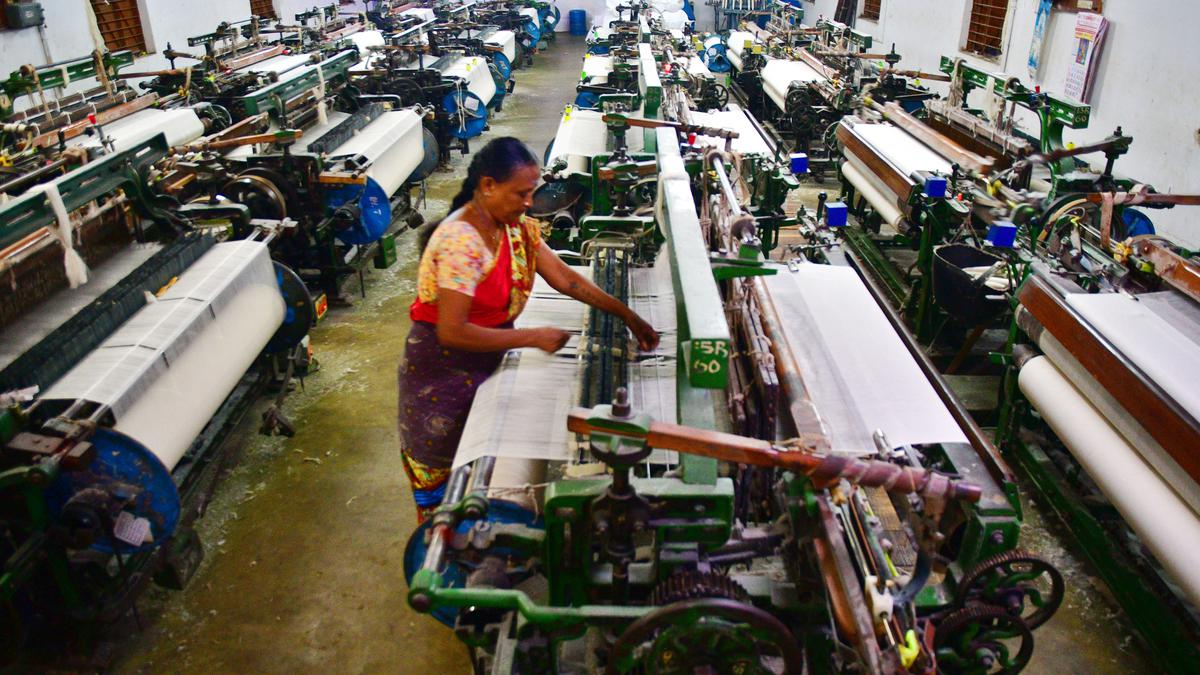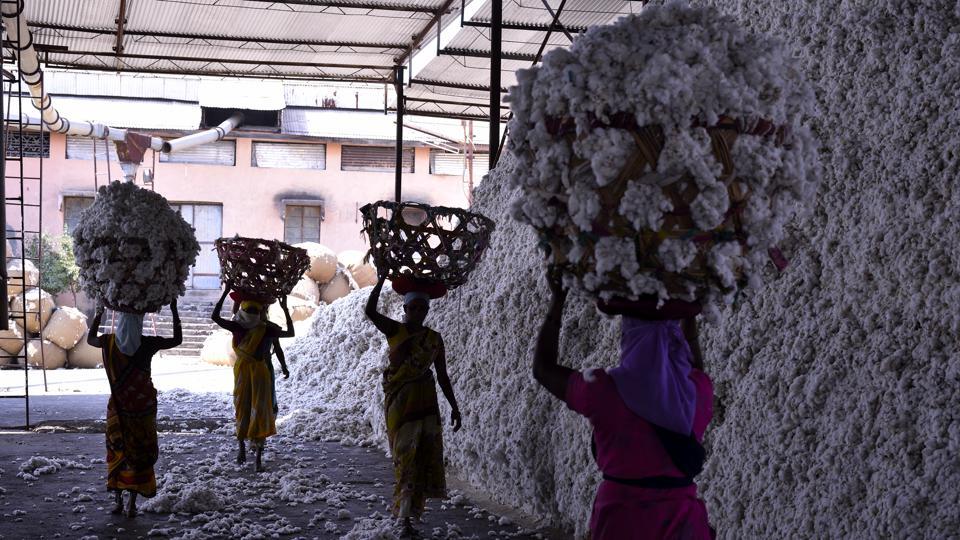Sivakumar, who operates a foundry in Coimbatore in Tamil Nadu, usually buys scrap from the southern districts of the State. However, recently he received 250 tonnes of scrap from a textile mill that had sold its machinery in Salem, a textile centre which is just a 3.5-hour drive from Coimbatore.
Similarly, in the powerloom cluster of Somanur in Tamil Nadu, Kandasamy, a weaver, says more than 10 looms are being sold away every month at his village (Devarayapuram) alone.
With such reports abound from clusters in T.N., J. Thulasidharan, president of the Indian Cotton Federation (ICF), says the current distress in the textile and garment industry, which is predominantly part of the MSME sector, is similar to the situation in the late 1960s.
Factories shutting
In the past couple of months, many factories across the textile value chain have either shut down and disposed of machinery or sold excess lands to stay in business; working hours have been reduced for labourers, impacting their wages; and the share of textiles and apparel in the Index of Industrial Production has shrunk.
In Andhra Pradesh, P. Koti Rao, who heads the A.P. Textile Mills Association, says 8-9 mills have closed down and more are on the verge of closure.

“It [textile mills] is a first generation industry in Andhra Pradesh. We used to export 30% of the yarn produced. Now, it is not even 5%. Cotton prices are high, electricity charges are up, and there is no support from the Centre or State governments,” he says. An oft-repeated cause for the crisis is that the industry is going through a prolonged period of low demand in both export and domestic markets.
The domestic demand is tepid though retail sales during the festival season this year was on a par with that of last year.
On the export front, shipment of textiles declined 0.41% in April-October 2023, compared with the same period last year even as it grew 24.29% in October 2023 as against October 2022.
Apparel exports saw an 8.08% degrowth in October and declined 14.58% in April-October 2023 compared with the same period last year.
Apparel shipments fall
Apparel shipments started declining last August, looked better in November and December 2022, but started registering negative growth again since January this year. The geopolitical situation, inflation in buying countries, and huge inventory with the retailers are said to have dampened orders. But, for the Indian textile and clothing industry, there are multiple issues stunting its growth and competitiveness — raw material prices, escalating input costs, quality control orders (QCO), and import of garments, to name a few.
Raw material (fibre) constitutes 60-70% of manufacturing cost, which has turned expensive in India impacting the competitiveness of the industry severely, says S.K. Sundararaman, chairman of the Southern India Mills’ Association. “Cotton prices crossed ₹1 lakh a candy in the last before season (2021-2022) and still textile mills were buying. Now, cotton prices are less than ₹60,000 a candy and there are no buyers,” said an official source.
The Indian textile sector is largely cotton based and production and yield of cotton in the country are on a downward trend.
In 2013-2014 cotton season, production and yield peaked to 398 lakh bales and 566 kg a hectare respectively.
In 2021-2022, the actual production was 310 lakh bales and yield 451 kg a hectare. Imposition of 10% import duty in 2021 led to a sharp rise in cotton prices that year and then a fall from last October, hurting farmers and the industry.
“Any decision of the government should be consistent and long term, benefiting farmers and the consumer industry. For more than a decade from 2008, India did not have import duty on cotton,” points out Nishanth Asher, secretary of ICF. At the present price levels, Indian cotton is on a par with the world average. Only if it stabilises at this level, can the industry make gains.
In the case of man-made fibre (MMF), domestic supply is limited and introduction of QCO is hurting the industry, say sources.
The average capacity utilisation of the textile industry in Gujarat is 70%, says Ashish, a weaving unit owner. “We used to import almost 20% of filament yarn. Now, we cannot because of the QCO. In the last two months, yarn price has increased by ₹5 a kg,” he adds.
Mr. Ashish and Sanjay Jain, another textile exporter, feel the government should have introduced QCO on garments and fabric instead of fibre. While there are restrictions on import of fibre, fabrics and garments are coming in mainly from Bangladesh.
Between January and September this year, fabric, apparel and home textiles worth $3,247.6 million were imported. Total textile imports during this period stood at $6,967 million.
Palanisamy, who manufactures undergarments in Tiruppur and and sells them in the domestic market, says, “A buyer from Kerala recently showed me a piece made in Bangladesh. It costs ₹25 while my product costs ₹30. Branded retailers are opening outlets in smaller towns too and they sell a lot of imported garments,” he says.
According to Rahul Mehta, chief mentor of the Clothing Manufacturers Association of India, “Those who compete on prices are affected the most because of imports. With Bangladesh having duty-free access to Indian market, those garments are available at 15-20% less cost in India.”
When fabric is imported, jobs are lost in cotton, spinning, knitting, compacting, and processing segments in India. So, on the lines of the ‘Make in India’ campaign, the government should encourage purchase of Indian textiles. While the current volume of imports are not much compared with the overall size of the domestic market, diversion of these orders to local manufacturers will bolster production, say industry sources.
In the international market too, Indian garment exporters continue to face price challenges. Buyers are cost conscious and despite the recent hike in wages in Bangladesh, Indian exporters do not expect major shift in orders. The overall cost difference between Indian and Bangladesh garments should be about 2-3%, but the labour costs are lesser in Bangladesh by almost 30%. With Bangladesh having duty-free access to the EU, Indian exporters are unable to make inroads.
Post the first wave of COVID-19, there was a huge demand and prices started moving up across the supply chain. This buoyed the domestic industry and capacities were added rapidly. With some of the States also offering incentives and packages to attract investments in textiles, there is over capacity in many segments. “Subsidies cannot continue for long and costs of labour or electricity will increase. The industry should work out the metrics to improve its competitiveness,” said Siddhartha Rajagopal, Executive Director of Cotton Textiles Export Promotion Council.
In clusters like Tiruppur, where the mainstay of the economy is the textile industry, rentals, retail sales, and restaurants are also bearing the brunt. “My godown has no takers for almost a year now,” said Sakthivel, a realtor. Muthupandi used to stitch 1,000 pieces of garments a day at an export house, earning 50 paise for a piece. He now gets only 50% of the work. “Even the money to buy tea is given only as an advance amount to workers,” he says.
The industry continues to hope for a revival in demand and the harbinger for that are cotton textile exports. Export of cotton yarn, fabrics, made-ups and handlooms is witnessing signs of revival since July this year, with outbound shipments crossing pre-COVID levels in October 2023.
“Cotton textile exports are normalising and home textiles are expected to lead the growth,” says Mr. Rajagopal.
But, what the industry needs urgently is policy intervention at the Centre and State-levels and holistic measures to improve competitiveness.
(This is the first of a four-part weekly series looking at India’s textile sector)
Source: thehindu.com

